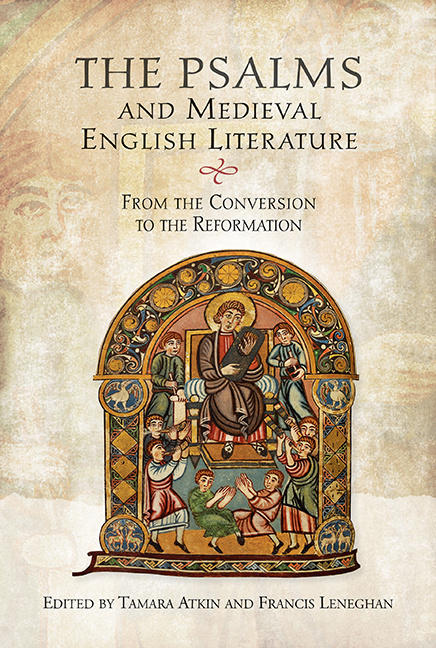Book contents
- Frontmatter
- Contents
- Figures
- Contributors
- Preface
- Acknowledgements
- Abbreviations
- Miscellaneous Frontmatter
- Introduction A Case Study of Psalm 50.13 in Old and Middle English
- I Translation
- 1 Some Anglo-Saxon Psalters and their Glosses
- 2 The Eadwine Psalter and Twelfth-Century English Vernacular Literary Culture
- 3 ‘In eching for the beste’: the Fourteenth-Century English Prose Psalter and the Art of Psalm Translation
- 4 The Wycliffite Psalms
- 5 Rolle's English Psalter and the Possibilities of Vernacular Scriptural Commentary
- II Adaptation
- III Voice
- Index
2 - The Eadwine Psalter and Twelfth-Century English Vernacular Literary Culture
from I - Translation
Published online by Cambridge University Press: 09 May 2017
- Frontmatter
- Contents
- Figures
- Contributors
- Preface
- Acknowledgements
- Abbreviations
- Miscellaneous Frontmatter
- Introduction A Case Study of Psalm 50.13 in Old and Middle English
- I Translation
- 1 Some Anglo-Saxon Psalters and their Glosses
- 2 The Eadwine Psalter and Twelfth-Century English Vernacular Literary Culture
- 3 ‘In eching for the beste’: the Fourteenth-Century English Prose Psalter and the Art of Psalm Translation
- 4 The Wycliffite Psalms
- 5 Rolle's English Psalter and the Possibilities of Vernacular Scriptural Commentary
- II Adaptation
- III Voice
- Index
Summary
The Eadwine Psalter, produced at Canterbury in the 1150s, is important, among many other reasons, because it contains the only translation of the Psalms into English copied between 1100 and 1300, between the Salisbury Psalter, glossed at Shaftesbury in Dorset, and the Surtees Psalter, a metrical translation composed in Yorkshire around 1300. The critical reception of this English gloss can be seen as a lightning rod for changing attitudes to twelfth-century English more generally, with longstanding complaints about its inaccuracy, inconsistency and probable incomprehensibility to its initial readership replaced by revisionist views asserting its ready intelligibility. This chapter treads a middle way between these two extremes, arguing that the gloss vacillates between archaic and contemporary modes and that this reflects a wider mid-twelfthcentury conflict about how English could best function as a literary language.
The English Gloss
The Eadwine Psalter, now Cambridge, Trinity College, MS R. 17. 1, is one of the most lavish manuscripts to survive from twelfth-century Britain. It weighs nearly thirteen kilograms and, open, occupies almost one third of a square metre; each bifolium was formed from the skin of a single animal. It contains the work of at least seventeen scribes and five or more artists, all apparently working at Christ Church, Canterbury around 1150. The cost of its production must have been vast, but its patronage remains unknown. The most natural comparanda are deluxe twelfth-century books like the St Albans Psalter and the Bury Bible. The ambition of the project is also evident in the manuscript' contents. The psalter proper was originally prefixed by a calendar and an eightleaf pictorial cycle of episodes from the Old and New Testaments. In addition to the Psalms, the psalter contains Canticles 1–15 and the apocryphal Psalm 151. Each psalm is preceded by a scholastic prologue, illustrated with a miniature and headed with a titulus; beneath is the text in the Hebraicum, Romanum and Gallicanum versions in three parallel columns. The Hebraicum is glossed in Anglo-Norman, the Romanum in English, and the Gallicanum with the Parva glosatura attributed to Anselm of Laon. Each psalm then concludes with a collect.
The English gloss to the Romanum, the principal focus of this essay, was, until recently, almost universally derided. Merritt characterized its glosses as ‘among the most inaccurate in Old English’, while Kuhn called the finished product ‘a remarkable linguistic gallimaufry’.
- Type
- Chapter
- Information
- The Psalms and Medieval English LiteratureFrom the Conversion to the Reformation, pp. 72 - 107Publisher: Boydell & BrewerPrint publication year: 2017

